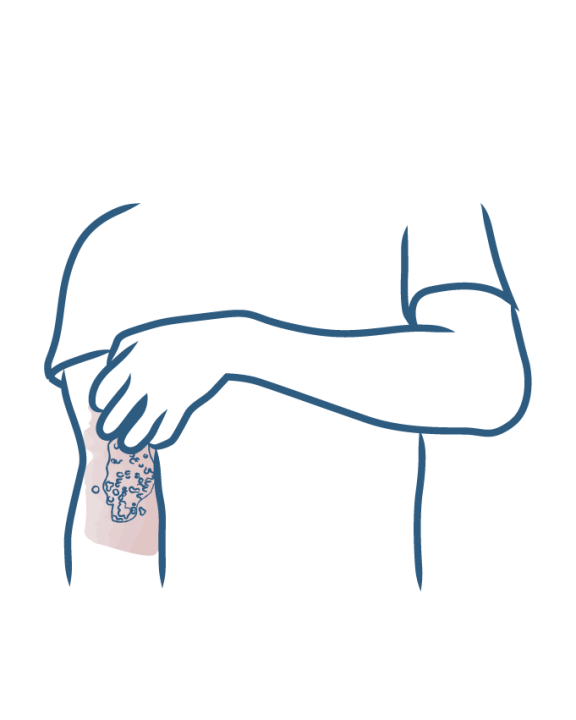What causes eczema?
- SUMMARY
- Eczema
Contact eczema due to nickel and chromium
- Living with eczema day to day
- What are the habits to avoid when you have eczema?
- Eczema cream, ointment: what should you use?
- What soap should be used for eczema?
- Swimming pool, swimming when you have eczema?
- Eczema: can it be cured?
- Eczema: how to treat itching
- Eczema: what foods should you eat?
- Eczema: What daily reflexes should you adopt?
- Which detergent should eczema patients use?
- Eczema: how can flare-ups be avoided?
- What causes eczema?
- Clothing contact eczema
- Perspiration-induced eczema
- Contact eczema due to cosmetics
- Contact eczema due to medication and topical treatments
- Hereditary eczema
- Contact eczema due to cleaning products
- Contact eczema due to nickel and chromium
- Allergy-induced eczema
- Stress-induced eczema
- Body eczema: hands, feet, arms, back, face, etc.
- Arm eczema (elbows, armpits, forearms)
- Foot eczema
- Eczema in the ears
- Scalp eczema
- Eczema on the back
- Eczema on the stomach and belly button
- Eczema around the mouth
- Leg eczema or varicose eczema
- Eczema of the eyelids, eyes or palpebral eczema
- Eczema on the neck and nape of the neck
- Facial eczema
- Hand and finger eczema (chronic hand eczema)
- What is infantile eczema?
- Eczema in babies: what habits should you adopt?
- How should you treat baby’s and infant’s eczema?
- When should you consult a physician about your baby's eczema?
- Cortisone cream to relieve eczema?
- What soap should be used for babies with eczema?
- Eczema in babies and children: the areas most often affected

Contact eczema due to nickel and chromium
Metals are a major source of contact eczema. Nickel eczema and chromium eczema are particularly common and require specific management.
Where are nickel and chromium found?
Nickel and chromium are ubiquitous metals, i.e. they are present almost everywhere. They can be the cause of an eczema flare-up in many contexts, both domestic and professional:
- Nickel and chromium are used in the composition of many metallic products. Nickel is combined with copper in coins and can lead to dermatitis in case of frequent handling (shopkeepers, waiters, etc.);
- Nickel is present in many clothes and accessories. Nickel allergy results in particular in an allergy to pants buttons, jewelry allergy, belt buckles allergy or even glasses allergy;
- Chromium is present in cement, paints, cleaning products but also in leather tanning products. Chromium allergy can therefore result in an allergy to shoes or leather sofas.
Who is affected by nickel and chromium contact eczema?
Allergic eczema due to nickel and chromium metals can affect anyone: both children and adults, in a professional environment (coins, kitchen utensils, tools, etc.) or domestic environment, with or without associated atopic dermatitis.
What is the best treatment for contact eczema due to nickel and chromium?
When a flare-up of contact eczema occurs, it should be treated by applying a cortisone cream to the plaques. A soothing repair cream applied to the lesions or on top of the topical corticosteroid reinforces its efficacy. Emollient applied as a follow-up hydrates the skin and prevents new flare-ups.
Contact allergy is highlighted by allergy tests. At the end of these tests, the physician gives the patient an avoidance list that includes the main sources of nickel or chromium, both in the workplace, at home and in food: tea, coffee, wine, beer, wholegrain starchy foods, pears, spinach, oysters, tinned food, etc. The method of cooking food is also to be taken into account: avoid using stainless steel containers, opt for glass, cast iron or Teflon.
More information
- Discover Contact eczema due to cleaning products
What causes eczema?
Contact eczema due to cleaning products
- Discover Contact eczema due to medication and topical treatments
What causes eczema?
Contact eczema due to medication and topical treatments
- Discover Allergy-induced eczema
What causes eczema?
Allergy-induced eczema
- Discover Stress-induced eczema
What causes eczema?
Stress-induced eczema
- Discover Contact eczema due to cosmetics
What causes eczema?
Contact eczema due to cosmetics
- Discover Perspiration-induced eczema
What causes eczema?
Perspiration-induced eczema
- Discover Clothing contact eczema
What causes eczema?
Clothing contact eczema
Our care routines
Skin prone to atopic eczema, contact eczema, chronic eczema and/or, eyelid eczema
Dermatological expertise
To better understand your skin and hair, discover our exclusive content and innovative care products designed to improve your quality of life..





